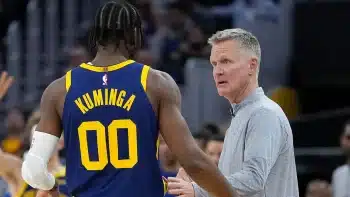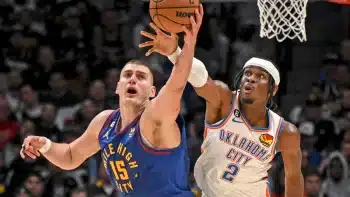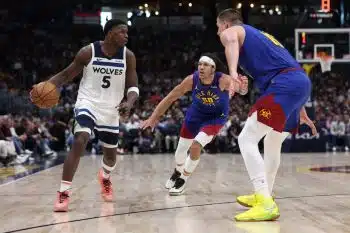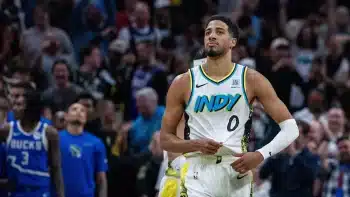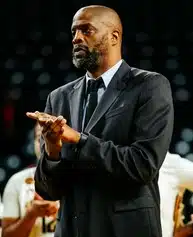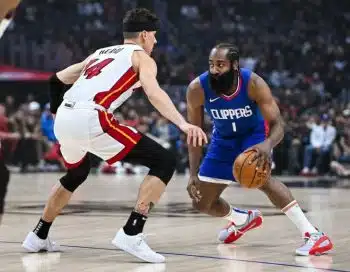NBA Draft
Does Noah Vonleh Actually Have Star Potential?

Noah Vonleh has recently gained momentum as a possible top-five pick, presumably on the strength of his strong pre-draft “performance.” He was a star of the NBA’s combine measurements, measuring 6’9.5 in shoes with a 7’4 wingspan and 9’0 standing reach. More surprisingly, he recorded a 37-inch approach vertical with a 31-inch standing leap, both outstanding numbers for a big man of his size and length. Vonleh is also a cut 247 lbs. and was measured at 7.3 percent body fat.*
*These body fat measurements mean very little (as will be explained below) but are quoted because it may affect Vonleh’s “momentum” if someone makes the mistake of thinking it is important.
The Indiana product is not just a paper tiger either. He was a great rebounder his freshman year and most importantly can shoot the ball from outside. Although he averaged only 1.1 attempts per game, he drained 48.5 percent of his threes on the year. He also has a nice stroke from the line, shooting at a solid 71.6 percent clip. And Vonleh is not hesitant to put the ball on the floor, while exhibiting solid jump hooks with either hand in the post. Many have compared Vonleh to Chris Bosh, and on the surface those comparisons are reasonable. A long, athletic, three-point shooting power forward who is a great rebounder sounds like a great pick for the top-five, right? Au contraire.
The problem with taking Vonleh in that lofty strata is his limited star potential. Let’s start with the physical tools first. He may indeed have jumped 37 inches at the combine, but let this be the annual reminder that watching a prospect is a much better way to judge basketball leaping ability than measuring maximum vertical.* Derrick Rose and O.J. Mayo were measured with the same vertical leap before the 2008 draft. Cody Zeller had a higher vertical than Dwight Howard and Blake Griffin. It just isn’t a reliable measure of how well a player jumps on the court compared to simply watching him play.
*That said, if I were running a workout, I would test standing, maximum approach one-foot, maximum approach two-foot, and second jump verticals. The way it is done now, players have the choice of approach vertical off one or two feet. Those really are totally different things especially for big guys who do most of their jumping off two feet to rebound, block shots and finish dumpoffs and post plays.
After watching almost all of Vonleh’s interior finishes this year, he clearly does not have any more than average applied leaping ability. He didn’t really dunk on anyone all year, and his interior finishing was actually pretty bad. At the rim* he shot only 59.3 percent, slightly below the 60.9 percent average for all college players. He just got stopped at the rim time and again, far more than a player of his stature should. It seems clear that he has below-average feel for finishing inside unless it is a hook shot.
*This metric is determined by shooting percentage on shots marked as dunks or layups by play-by-play, per Hoop-Math.com. This data should be taken with a grain of salt since it is likely that there are not universal standards from scorer to scorer across Division I of what constitutes a “lay-up.” Indiana as a whole did not have great interior finishers, but it is worth nothing that they shot only 56.2 percent in Hoop-Math’s “at the rim” metric, so there is at least some small amount of evidence that their official scorers might have been more expansive in classifying certain shots as layups. Nevertheless, Vonleh did not rate well.
Vonleh’s post game is seductive due to his pretty hook shots, but ultimately not particularly efficient. He struggled to create both horizontal and vertical separation, and does not really have any moves aside from those hooks. The same lack of separation was evident on his drives. Despite his shooting ability he almost never is able to beat his man on a straight line drive, usually having to resort to a spin move after he has been cut off. He does not project to be able to get to the basket off the bounce against most NBA power forwards.
Another concern big concern for Vonleh is his awful hands. While he admirably runs the floor hard, he ranked in only the 15th percentile among college players in transition points per possession because he reliably fumbled passes going to the rim. Even those low numbers were goosed by transition threes, it really was shocking how bad he was catching the ball on the move going to the basket. The same issue afflicts his pick and roll finishing, as does the fact that it takes him forever to load up to jump. Unless he can really improve in this area, his usefulness in the pick and roll will be largely limited to popping for jumpers.
The problems with his feel for the game are also borne out by his poor passing numbers. He had only 18 assists all season against 64 turnovers. When he received the ball he was largely a black hole, and his over reliance on spin moves resulted in frequent turnovers.
Many have commented that Vonleh was criminally underutilized at Indiana, and indeed he only had a below-average 18.9 percent usage rate in conference play. But while he was the victim of some gunning by the guards, he deserves at least some of the blame for his inability to find shots. This is another indicator that his feel is not the greatest.
Of perhaps the greatest importance for his future, his defensive instincts are poor. Vonleh does move well laterally and is solid on ball against the pick and roll and postups. In the latter situation he uses his chest to bump the offensive player without fouling and does well to avoid getting backed down. But you would expect a player with his wingspan, vertical and lateral quickness to be a terror protecting the rim. Vonleh is not. He often gets caught out of position to help, especially when his man drifts to the perimeter. Seeing his man and the ball is not his strong suit, and drivers can reach the rim before Vonleh is even aware of them if he is weakside. And when he is in position, he lacks the timing and bounce to block many shots. To these eyes, he does not project as a good rim-protector.
Ultimately, Vonleh has many basketball skills, but he is not a great basketball player. Those skills do make him worth drafting starting in the late lottery, and there is a chance as one of the younger players in the draft (he only turns 19 in August) that he develops the necessary feel to be a star. But right now, his likely outcome seems closer to a three-point shooting version of Jason Thompson. That could be a valuable player, but to me he lacks the high-probability upside to merit a pick in the top-half of the lottery.
Body Fat Testing Is Wildly Inaccurate
It is time for the NBA to stop doing body fat testing at the combine. The league uses the skinfold method to measure body fat, which involves a human physically pinching skin with calipers and measuring how thick it is at a number of points around the body. While there is a specific method to doing this that is supposed to be accurate, as you might imagine the pinching of skin is not particularly precise. Then a formula is supposed to estimate body fat based on how much skin is in the fold. Consider the potential variance of different people doing the testing, and you get a margin of error of five percent. That means plus or minus five percent, meaning a player could have as much as 10 percent variance between two tests. Nik Stauskas got dinged on the testing this year, measuring a relatively high 12.1 percent, spawning “concerns” about how fat he was. Stauskas looks plenty cut and athletic—the concerns should be with the testing itself.
In reality, body fat testing to differentiate between the low body fat percentages of elite athletes is fairly worthless because almost every feasible testing method lacks the necessary precision. Even ostensibly more accurate measure have a very high variance. The Bod Pod (air displacement) and hydrostatic weighing (water displacement) purport to measure body fat by determining how much matter is displaced by the body to determine its volume, then determining the body’s density by dividing that volume by the subject’s weight. The calculated density can vary quite a bit based on how much air is in the lungs, the person’s level of hydration and just simple measurement error by the machine.
After the density is determined, an equation is used to estimate body fat based on the density of the average person’s fat and non-fat mass.* Even by these methods, readings taken back to back on the same person can vary by five percent or more.
*Sometimes a different equation is used for African-Americans, on the basis that they typically have lower body fat percentages than other races and the result should be adjusted downward simply on the basis of race. This too seems another possible source of inaccuracy. I do not know whether such an adjustment is used with the skinfold method the NBA uses at the combine.
Labeling certain players as more in shape than others based solely on this testing is rather asinine unless a guy has an absolutely astronomical number in the mid-to-high teens. Just subjectively looking at how cut a player is does a much better job determining whether he could improve his performance by losing fat. Hopefully GMs do not put any stock in this testing, but if I were an agent I would not let my player be tested just to avoid potentially getting Stauskased. Responsible journalists should stop quoting these figures like they actually mean anything.
